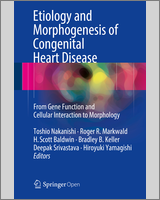Open Access This chapter is distributed under the terms of the Creative Commons Attribution-Noncommercial 2.5 License (http://creativecommons.org/licenses/by-nc/2.5/), which permits any noncommercial use, distribution, and reproduction in any medium, provided the original author(s) and source are credited. The images or other third party material in this chapter are included in the work's Creative Commons license, unless indicated otherwise in the credit line; if such material is not included in the work's Creative Commons license and the respective action is not permitted by statutory regulation, users will need to obtain permission from the license holder to duplicate, adapt or reproduce the material.
NCBI Bookshelf. A service of the National Library of Medicine, National Institutes of Health.
Nakanishi T, Markwald RR, Baldwin HS, et al., editors. Etiology and Morphogenesis of Congenital Heart Disease: From Gene Function and Cellular Interaction to Morphology [Internet]. Tokyo: Springer; 2016. doi: 10.1007/978-4-431-54628-3_28

Etiology and Morphogenesis of Congenital Heart Disease: From Gene Function and Cellular Interaction to Morphology [Internet].
Show detailsCongenital heart disease is still the leading cause of death within the first year of life. Our lab forces on understanding the morphology of congenital heart disease. Outflow tract anomalies, including abnormal alignment or septation, account for 30 % of all congenital heart disease. To solve the developmental problem of these defects, we are interested in the role of the second heart field (SHF) that gives rise to the outflow tract structure.
Keywords:
Tbx1, Truncus arteriosus, Environmental modificationCongenital heart disease is still the leading cause of death within the first year of life. Our lab forces on understanding the morphology of congenital heart disease. Outflow tract anomalies, including abnormal alignment or septation, account for 30 % of all congenital heart disease. To solve the developmental problem of these defects, we are interested in the role of the second heart field (SHF) that gives rise to the outflow tract structure.
TBX1, a member of the T-box family of transcription factors, is a major genetic determinant of 22q11 deletion syndrome (22q11DS) in human. 22q11DS is the most frequent chromosomal microdeletion syndrome in human and characterized by abnormal development of the cardiac outflow tract, such as persistent truncus arteriosus (PTA), tetralogy of Fallot, interrupted aortic arch, and ventricular septal defects.
In the developing murine heart, Tbx1 is expressed in the SHF, but not in the cardiac neural crest cells (NCCs). Our past experiments suggested that sonic hedgehog signal was necessary for maintenance of the Tbx1 expression in the pharyngeal mesoderm including the SHF [1]. Tbx1 null (Tbx1−/−) mice demonstrated PTA reminiscent of the 22q11DS heart phenotype. We generated Tbx1 hypomorphic allele (Tbx1neo/+) [2] for attempting to recapitulate the human genotype and phenotype correlation. Mice homozygous for this hypomorphic allele expressed around 25 % of Tbx1 mRNA compared to wild-type mice. We demonstrated that Tbx1 is a dosage-dependent gene and believe that the Tbx1 dosage can be affected by genetic and/or environmental modifiers because of highly variable phenotype of 22q11DS instead of the relatively uniform chromosomal microdeletion. We are trying to create the phenotype variability of PTA in this hypomorphic model (Fig. 28.1) by application of environmental modifiers. Through this study, we would better understand the interaction between the gene dosage and environmental factors during the development of outflow tract defects.

Fig. 28.1
Coronal sections of Tbx1+/+ (a, b) and Tbx1neo/neo (c, d) embryos at E13.5. Tbx1+/+ showed the normal outflow tract (OFT) septation, whereas Tbx1neo/neo demonstrated PTA. Ao Aorta, PA pulmonary artery
References
- 1.
- Yamagishi H, Maeda J, Hu T, et al. Tbx1 is regulated by tissue-specific forkhead proteins through a common Sonic hedgehog-responsive enhancer. Gene Dev. 2003;17:269–81. [PMC free article: PMC195981] [PubMed: 12533514] [CrossRef]
- 2.
- Hu T, Yamagishi H, Maeda J, et al. Tbx1 regulates fibroblast growth factors in the anterior heart field through a reinforcing autoregulatory loop involving forkhead transcription factors. Development. 2005;131:5491–502. [PubMed: 15469978] [CrossRef]
- MEF2C regulates outflow tract alignment and transcriptional control of Tdgf1.[Development. 2016]MEF2C regulates outflow tract alignment and transcriptional control of Tdgf1.Barnes RM, Harris IS, Jaehnig EJ, Sauls K, Sinha T, Rojas A, Schachterle W, McCulley DJ, Norris RA, Black BL. Development. 2016 Mar 1; 143(5):774-9. Epub 2016 Jan 25.
- Review Tbx1, subpulmonary myocardium and conotruncal congenital heart defects.[Birth Defects Res A Clin Mol T...]Review Tbx1, subpulmonary myocardium and conotruncal congenital heart defects.Parisot P, Mesbah K, Théveniau-Ruissy M, Kelly RG. Birth Defects Res A Clin Mol Teratol. 2011 Jun; 91(6):477-84. Epub 2011 May 17.
- Prdm1 functions in the mesoderm of the second heart field, where it interacts genetically with Tbx1, during outflow tract morphogenesis in the mouse embryo.[Hum Mol Genet. 2014]Prdm1 functions in the mesoderm of the second heart field, where it interacts genetically with Tbx1, during outflow tract morphogenesis in the mouse embryo.Vincent SD, Mayeuf-Louchart A, Watanabe Y, Brzezinski JA 4th, Miyagawa-Tomita S, Kelly RG, Buckingham M. Hum Mol Genet. 2014 Oct 1; 23(19):5087-101. Epub 2014 May 12.
- Visualization of outflow tract development in the absence of Tbx1 using an FgF10 enhancer trap transgene.[Dev Dyn. 2007]Visualization of outflow tract development in the absence of Tbx1 using an FgF10 enhancer trap transgene.Kelly RG, Papaioannou VE. Dev Dyn. 2007 Mar; 236(3):821-8.
- Review Morphogenesis and molecular considerations on congenital cardiac septal defects.[Ann Med. 2014]Review Morphogenesis and molecular considerations on congenital cardiac septal defects.Gittenberger-de Groot AC, Calkoen EE, Poelmann RE, Bartelings MM, Jongbloed MR. Ann Med. 2014 Dec; 46(8):640-52. Epub 2014 Oct 13.
- Modification of Cardiac Phenotype in Tbx1 Hypomorphic Mice - Etiology and Morpho...Modification of Cardiac Phenotype in Tbx1 Hypomorphic Mice - Etiology and Morphogenesis of Congenital Heart Disease
Your browsing activity is empty.
Activity recording is turned off.
See more...
 1.
1.